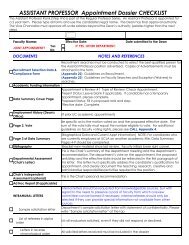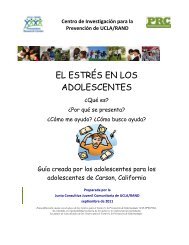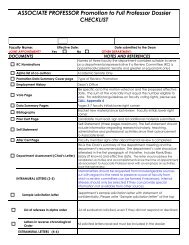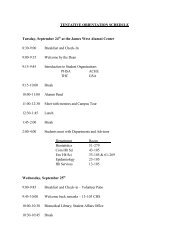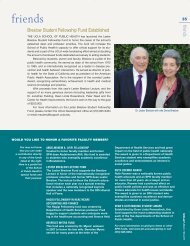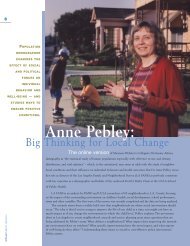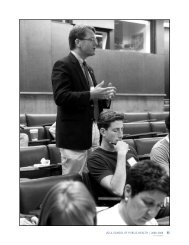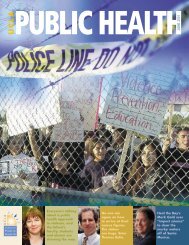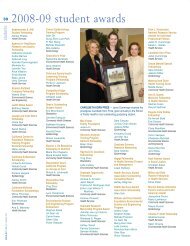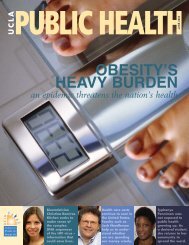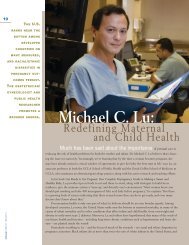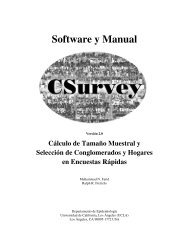A BROADER VIEWOF HEALTH: - UCLA School of Public Health
A BROADER VIEWOF HEALTH: - UCLA School of Public Health
A BROADER VIEWOF HEALTH: - UCLA School of Public Health
Create successful ePaper yourself
Turn your PDF publications into a flip-book with our unique Google optimized e-Paper software.
<strong>Health</strong> Care Policy and Research and he has been actively involved in national,<br />
state and pr<strong>of</strong>essional oral health policy development ever since. From 2000<br />
to 2008 he was director <strong>of</strong> the <strong>Health</strong> Resources and Services Administration/<br />
Maternal and Child <strong>Health</strong> Bureau National Oral <strong>Health</strong> Policy Center, colocated<br />
within the Center for <strong>Health</strong>ier Children, Families and Communities.<br />
Crall also directs a pediatric dentistry leadership training program in collaboration<br />
with other members <strong>of</strong> the center’s faculty. Since 2007 he has been project<br />
director <strong>of</strong> the American Academy <strong>of</strong> Pediatric Dentistry’s Head Start Dental<br />
Home Initiative, which is building networks <strong>of</strong> providers in every state to<br />
improve access to dental services for children in Head Start programs.<br />
Crall, who was part <strong>of</strong> Andersen’s national evaluation team for the Dental<br />
Pipeline Program, believes public health efforts to address the current challenges<br />
in oral health require a combination <strong>of</strong> innovative training initiatives and community<br />
programs, along with policies that effect change in the practice environment,<br />
such as increased reimbursement and other incentives to work with underserved<br />
populations.<br />
The subspecialty area <strong>of</strong> dental public health is small, Crall notes; it will<br />
take more than dentists to make a difference. “We need to encourage more dentists<br />
to go into public health, but we also must find ways to foster collaborations<br />
with non-dentists in public health and medicine,” he says. “That’s now occurring<br />
at <strong>UCLA</strong> in a way that we haven’t seen before, and it’s a goal that has gained<br />
increasing recognition at the national level.”<br />
M.P.H. Degree Informs Her Effort to<br />
Organize American Indian Dentists<br />
Nowhere are oral health problems more severe than among American Indians. The last<br />
survey by the Indian <strong>Health</strong> Service (IHS), published in 1999, found that 87 percent <strong>of</strong><br />
American Indian children ages 6-14 and 91 percent <strong>of</strong> 15-19 year olds had a history <strong>of</strong><br />
tooth decay. Seventy-eight percent <strong>of</strong> adults ages 35-44 and 98 percent <strong>of</strong> those 55 and<br />
older had lost at least one tooth because <strong>of</strong> dental decay, gum disease or oral trauma.<br />
Dr. Ruth Bol (M.P.H. ’09), a pediatric dentist in private practice in Menifee, Calif.,<br />
who is herself American Indian, is drawing on her <strong>UCLA</strong> <strong>School</strong> <strong>of</strong> <strong>Public</strong> <strong>Health</strong><br />
education to organize American Indian dentists in response to the problem. Bol worked<br />
four years with the IHS (part <strong>of</strong> the U.S. <strong>Public</strong> <strong>Health</strong> Service) and became frustrated<br />
with the lack <strong>of</strong> leadership, which she believed had much to do with the scarcity <strong>of</strong><br />
American Indians among the dentists practicing on the reservations.<br />
So she worked her way up the ranks <strong>of</strong> the Society <strong>of</strong> American Indian Dentists<br />
(Bol is currently vice president), was elected to the California Dental Association board<br />
<strong>of</strong> directors and became active in the American Dental Association. Realizing the value<br />
a public health education could bring, Bol enrolled at <strong>UCLA</strong> for both her pediatric dentistry<br />
residency and M.P.H. from the <strong>School</strong> <strong>of</strong> <strong>Public</strong> <strong>Health</strong>. With a grant she wrote in one <strong>of</strong><br />
her <strong>School</strong> <strong>of</strong> <strong>Public</strong> <strong>Health</strong> courses, Bol secured funding from Delta Dental <strong>of</strong> California<br />
to support the Society <strong>of</strong> American Indian Dentists’ efforts to mentor American Indians<br />
before, during and after dental school. She is currently meeting with other potential<br />
funders.<br />
“The more I got involved with these big-picture issues, the more I realized there<br />
was a lot I didn’t know,” Bol says. “Getting the M.P.H. has given me credibility as well<br />
as knowledge on everything from developing and evaluating programs to writing grants.<br />
It’s provided me with the tools to work with underserved communities.”<br />
Ruth Bol, D.D.S. M.P.H. ’09<br />
7<br />
feature <strong>UCLA</strong>PUBLIC <strong>HEALTH</strong>



